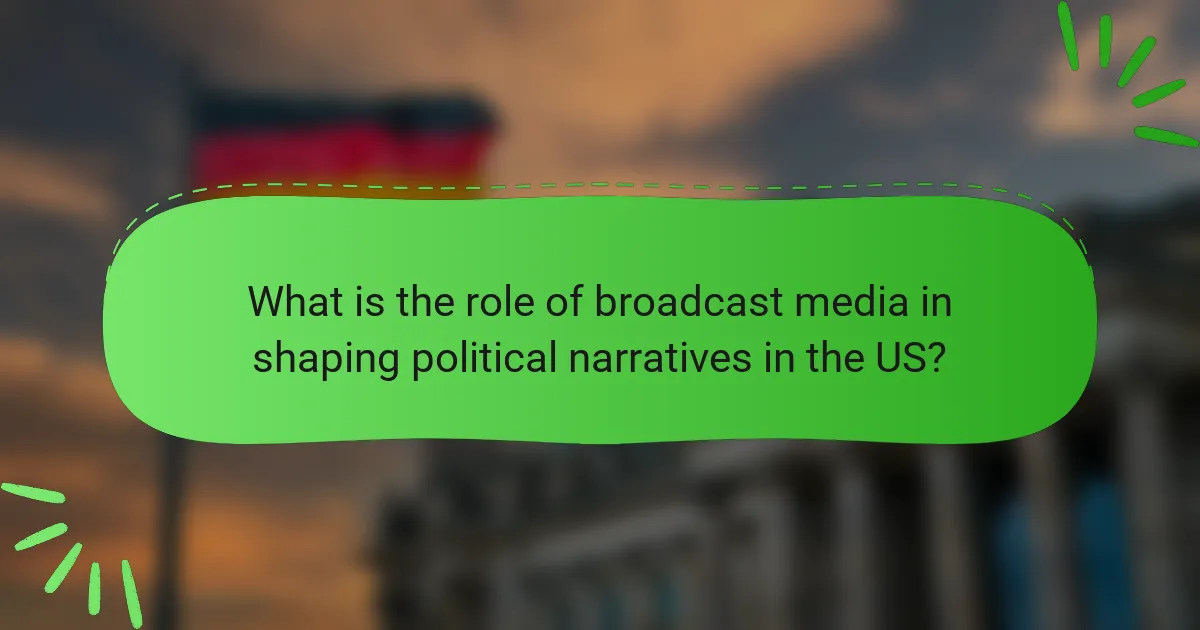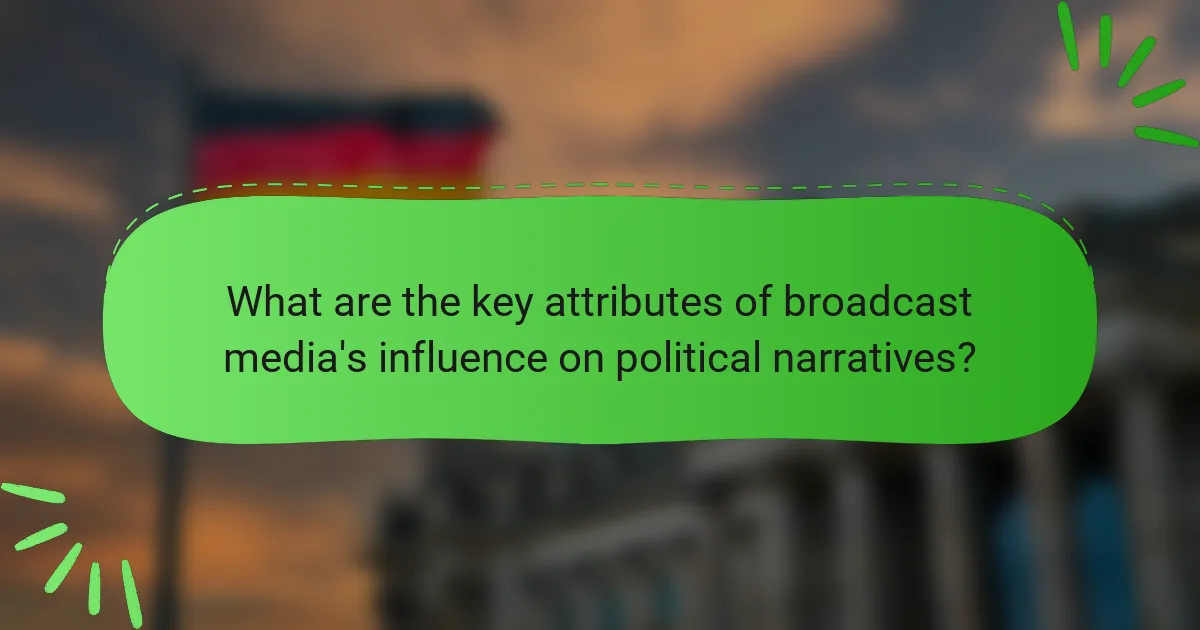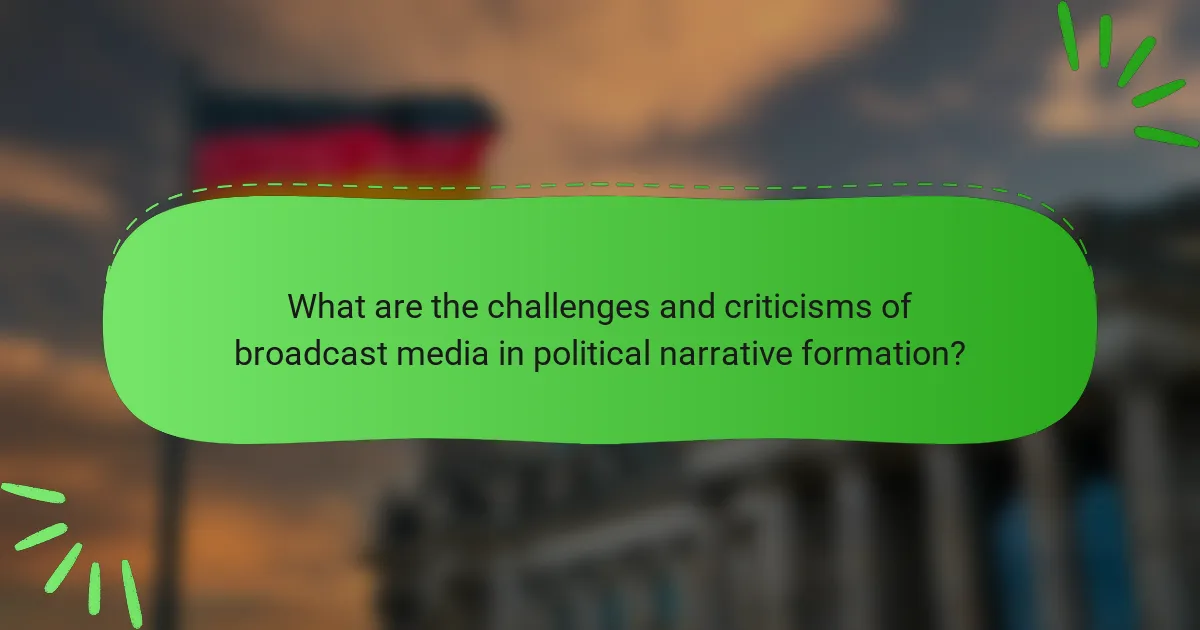Broadcast media is a key entity in shaping political narratives in the United States, significantly influencing public perception and opinion through its news coverage, commentary, and analysis. Major networks such as CNN, Fox News, and MSNBC have the ability to frame political issues by selectively highlighting stories, thus impacting voter behavior and attitudes. This article examines the role of broadcast media in providing accessible and immediate reporting, the implications of framing on public understanding, and the challenges it faces, including bias, sensationalism, and underrepresentation of diverse perspectives. It also explores the historical context of broadcast media’s influence on the political landscape, emphasizing its power as a tool for shaping discourse and electoral outcomes.

What is the role of broadcast media in shaping political narratives in the US?
Broadcast media plays a crucial role in shaping political narratives in the US. It influences public perception and opinion through news coverage, commentary, and analysis. Major networks like CNN, Fox News, and MSNBC have significant reach and impact. They frame political issues by selecting which stories to highlight. This selection can sway public understanding and priorities. For example, coverage of elections often emphasizes specific candidates’ strengths or weaknesses. Studies show that media framing affects voter behavior and attitudes. The portrayal of events can lead to differing interpretations among audiences. Thus, broadcast media serves as a powerful tool in shaping the political landscape.
How has broadcast media influenced political discourse throughout history?
Broadcast media has significantly influenced political discourse throughout history by shaping public opinion and facilitating political communication. The advent of radio in the 1920s allowed politicians to reach wider audiences directly. Franklin D. Roosevelt’s “Fireside Chats” exemplified this, as they fostered a personal connection with citizens during the Great Depression. Television further transformed political discourse in the 1950s and 1960s, bringing campaigns into homes. The Kennedy-Nixon debates in 1960 showcased the impact of visual media on voter perceptions. Additionally, broadcast media has played a critical role in agenda-setting, highlighting specific issues while marginalizing others. Studies indicate that media coverage can sway public opinion and influence election outcomes. For instance, the Watergate scandal was largely uncovered through investigative journalism on television, leading to significant political consequences. Overall, broadcast media has been a powerful tool in shaping political narratives and public engagement in the political process.
What key historical events illustrate the impact of broadcast media on politics?
The key historical events that illustrate the impact of broadcast media on politics include the 1960 Kennedy-Nixon presidential debate. This debate was the first to be televised and significantly influenced public perception. Viewers who watched the debate on television favored Kennedy, while radio listeners preferred Nixon. Another event is the Watergate scandal, which was extensively covered by television news. This coverage played a crucial role in shaping public opinion and led to President Nixon’s resignation. The Gulf War in 1991 also showcased the power of broadcast media. Live coverage of the conflict brought the war into American living rooms, affecting public support for military actions. These events demonstrate how broadcast media has shaped political narratives and influenced electoral outcomes.
How did early broadcast media change the landscape of political communication?
Early broadcast media transformed political communication by enabling mass dissemination of information. This shift allowed politicians to reach larger audiences directly. Radio and television provided a platform for candidates to present their messages in a more personal manner. The 1930s saw Franklin D. Roosevelt utilize radio effectively through his “Fireside Chats.” These broadcasts fostered a sense of intimacy and trust between the president and the public. Television further amplified this effect in the 1950s, with the first televised presidential debate between John F. Kennedy and Richard Nixon in 1960. This debate highlighted the importance of image and presentation in politics. As a result, broadcast media became a crucial tool for shaping public opinion and political narratives.
Why is understanding the historical perspective of broadcast media important?
Understanding the historical perspective of broadcast media is important because it reveals how media has shaped public opinion and political narratives. Historical analysis shows the evolution of broadcast media from radio to television and now digital platforms. Each phase has influenced political communication strategies significantly. For instance, Franklin D. Roosevelt’s use of radio during the Great Depression established a direct connection with the public. Similarly, televised debates, such as the 1960 Kennedy-Nixon debate, transformed electoral politics. These examples illustrate that understanding past media practices informs current media literacy and critical analysis of information. Historical context also highlights the role of media in social movements, such as the Civil Rights Movement, where broadcast media played a pivotal role in raising awareness and mobilizing support. Thus, exploring the historical trajectory of broadcast media equips individuals with insights into its ongoing impact on democracy and society.
What lessons can be learned from past political narratives shaped by broadcast media?
Past political narratives shaped by broadcast media reveal critical lessons about influence and public perception. Broadcast media can significantly frame political issues and candidates. For example, the 1960 Kennedy-Nixon debate showcased how visual presentation impacts voter perception. Kennedy’s confident demeanor contrasted with Nixon’s less polished appearance. This event highlighted the importance of image in politics. Additionally, media coverage can amplify specific narratives while sidelining others. The Vietnam War coverage influenced public opinion and policy decisions dramatically. These instances demonstrate that broadcast media shapes political dialogue and can alter electoral outcomes. Understanding these dynamics is essential for analyzing contemporary political communication.
How does the evolution of broadcast media reflect societal changes in the US?
The evolution of broadcast media mirrors societal changes in the US by adapting to shifts in technology, culture, and political climate. Initially, radio and television served as primary sources of information, shaping public opinion during significant events like World War II and the Civil Rights Movement. The introduction of cable television in the 1980s diversified content and reflected the growing demand for specialized programming. The rise of the internet and streaming services in the 2000s further transformed broadcast media, allowing for greater access to information and participation in political discourse. Social media platforms now enable real-time interaction and have become essential for political campaigns and grassroots movements. Each phase of media evolution corresponds with changing societal values, such as increased demand for representation and inclusivity. This progression illustrates how broadcast media not only reflects but also influences public sentiment and political priorities in the US.

What are the key attributes of broadcast media’s influence on political narratives?
Broadcast media significantly influences political narratives through accessibility, immediacy, and framing. Accessibility ensures that a wide audience can consume political content. Immediacy allows for real-time reporting of events, shaping public perception quickly. Framing involves the presentation of information, which can highlight certain aspects while downplaying others. Studies show that the way news is framed can alter public opinion. For instance, research by Entman (1993) indicates that framing affects how audiences interpret political issues. Additionally, broadcast media serves as a primary source of information for many voters, impacting electoral outcomes. The combination of these attributes creates a powerful tool for shaping political discourse.
What types of broadcast media have played significant roles in politics?
Television, radio, and online streaming platforms have played significant roles in politics. Television has been a primary medium since the 1950s, influencing public opinion through political debates and news coverage. Radio was crucial in the early 20th century, providing immediate updates and fostering a connection between politicians and the public. Online streaming platforms have emerged recently, allowing for direct communication between candidates and voters. Each medium shapes political narratives by reaching diverse audiences and facilitating engagement. Historical events, such as the 1960 Kennedy-Nixon debate on television, illustrate the impact of broadcast media on electoral outcomes.
How do television and radio differ in their impact on political messaging?
Television and radio differ significantly in their impact on political messaging. Television combines visual and auditory elements, enhancing emotional engagement. This medium allows for visual storytelling, which can create a stronger connection with viewers. Studies show that visual content can lead to higher retention of information during political campaigns. In contrast, radio relies solely on audio, which engages listeners differently. It fosters imagination and personal interpretation of messages. Research indicates that radio can reach audiences in more intimate settings, often leading to a sense of trust. The immediacy of radio broadcasts can also create a sense of urgency in political messaging. Therefore, while both mediums influence political narratives, their methods of engagement and audience connection vary distinctly.
What role do news programs and talk shows play in shaping public opinion?
News programs and talk shows significantly influence public opinion by providing information and framing issues. They curate news content, highlighting specific topics that shape viewers’ perceptions. This selective presentation can create a narrative that aligns with certain viewpoints. Research indicates that media exposure affects political attitudes and behaviors. For instance, studies show that people who consume partisan news are more likely to adopt similar political beliefs. Furthermore, talk shows often feature discussions that amplify particular perspectives, further steering public discourse. The interplay between entertainment and news can also engage audiences emotionally, making them more receptive to specific messages.
How do broadcast media narratives affect voter behavior?
Broadcast media narratives significantly influence voter behavior by shaping public perception and opinion. These narratives often frame political issues and candidates in ways that can sway voter attitudes. For instance, studies show that media coverage can enhance a candidate’s visibility and perceived electability. According to a 2019 study by the Pew Research Center, 62% of voters reported that news coverage affected their views on candidates. Additionally, the framing of issues in broadcast media can lead to agenda-setting, where certain topics become prioritized in public discourse. This process can mobilize voters around specific issues, impacting election outcomes. Historical examples include the role of televised debates in the 1960 presidential election, where media portrayal influenced public perception of candidates. Overall, broadcast media narratives play a crucial role in determining how voters understand and engage with political content.
What psychological mechanisms are triggered by political messages in broadcast media?
Political messages in broadcast media trigger several psychological mechanisms. These mechanisms include confirmation bias, emotional appeal, and social identity theory. Confirmation bias occurs when individuals favor information that aligns with their pre-existing beliefs. This leads to selective exposure to media that reinforces those views. Emotional appeal engages viewers by eliciting strong feelings, which can influence attitudes and behaviors. Social identity theory suggests that individuals identify with groups represented in media, impacting their political opinions. Research shows that emotionally charged political ads are more effective in changing voter perceptions. For instance, a study by Brader (2006) found that emotional content in political advertisements significantly affects viewer engagement and response.
How do media framing and agenda-setting influence electoral outcomes?
Media framing and agenda-setting significantly influence electoral outcomes by shaping public perception and prioritizing issues. Media framing refers to how information is presented, affecting audience interpretation. For instance, framing a candidate as an outsider can create a perception of change. Agenda-setting determines which issues are highlighted, influencing voter priorities. Research shows that when the media emphasizes certain topics, voters consider them more important. A study by McCombs and Shaw (1972) demonstrated that media coverage directly impacts public concern about issues. Thus, the way media frames candidates and sets agendas plays a crucial role in determining electoral results.

What are the challenges and criticisms of broadcast media in political narrative formation?
Broadcast media faces significant challenges and criticisms in political narrative formation. One major challenge is the potential for bias, which can skew public perception. Studies show that media outlets often reflect the political leanings of their ownership, impacting narrative framing. Additionally, the pressure for ratings can lead to sensationalism, prioritizing entertainment over informative content. This sensationalism can distort complex political issues into oversimplified narratives. Another criticism is the lack of diversity in perspectives, which limits the scope of political discourse. Research indicates that marginalized voices are often underrepresented, affecting the overall narrative landscape. Furthermore, the rapid pace of news cycles can result in misinformation being disseminated before verification. This can lead to public confusion and misinterpretation of political events. Overall, these challenges highlight the intricate role of broadcast media in shaping political narratives.
What are the common criticisms of broadcast media’s role in politics?
Common criticisms of broadcast media’s role in politics include sensationalism, bias, and lack of depth. Sensationalism often prioritizes dramatic stories over substantive issues. This can distort public perception of important political matters. Bias in reporting can lead to skewed representations of political parties and candidates. Studies show that media outlets may favor particular viewpoints, affecting audience opinions. Additionally, broadcast media frequently oversimplifies complex political issues. This lack of depth can hinder informed public discourse. Critics argue that these factors contribute to polarization in society. Overall, these criticisms highlight significant challenges in the media’s influence on politics.
How do issues of bias and misinformation affect political narratives?
Bias and misinformation significantly distort political narratives. These issues create skewed perceptions among the public. For instance, biased reporting can lead to selective exposure to information. This results in echo chambers where individuals only hear views that reinforce their beliefs. Misinformation spreads rapidly through social media platforms. A study by the Pew Research Center found that 64% of Americans believe misinformation has a major impact on political discourse. Consequently, political narratives become polarized and less fact-based. This undermines public trust in media and institutions. Ultimately, bias and misinformation hinder informed civic engagement.
What impact does media consolidation have on political diversity?
Media consolidation negatively impacts political diversity. It reduces the number of independent voices in the media landscape. When fewer companies control media outlets, diverse viewpoints are often marginalized. This concentration leads to a homogenization of news coverage. Studies show that local news sources are often replaced by national narratives. A report from the Pew Research Center found that local newsrooms have declined by 50% since 2004. This decline limits the representation of varied political perspectives. As a result, audiences receive a narrower range of information. This can influence public opinion and voter behavior significantly.
How can individuals critically engage with broadcast media narratives?
Individuals can critically engage with broadcast media narratives by analyzing content for bias and perspective. This involves questioning the sources of information presented. Viewers should evaluate the framing of stories and the language used. Comparing multiple news outlets can reveal differing viewpoints. Fact-checking claims made in broadcasts enhances understanding. Engaging with media literacy resources builds skills for critical analysis. Research indicates that media literacy improves audience discernment of biases (Hobbs, 2010). By actively questioning and seeking diverse perspectives, individuals can better understand political narratives shaped by broadcast media.
What strategies can be employed to assess the credibility of broadcast media sources?
To assess the credibility of broadcast media sources, verify the source’s reputation. Established outlets typically adhere to journalistic standards. Check for transparency in sourcing and citations. Credible media often provide references for their claims. Evaluate the expertise of the journalists involved. Experienced reporters usually deliver more reliable information. Analyze the objectivity of the content. Bias can undermine credibility. Cross-reference information with multiple reputable sources. Consensus among various outlets enhances reliability. Lastly, consider the publication date. Timeliness is crucial for news accuracy.
How can viewers become more informed consumers of political information?
Viewers can become more informed consumers of political information by critically evaluating sources. They should verify the credibility of news outlets and check for bias. Fact-checking organizations can help assess the accuracy of claims. Engaging with multiple perspectives fosters a well-rounded understanding. Research indicates that diverse media consumption improves political knowledge. According to a Pew Research study, cross-referencing information from various outlets enhances discernment. Additionally, viewers should seek out non-partisan resources for balanced insights. Active participation in discussions can also deepen comprehension of political issues.
The main entity of this article is broadcast media and its influence on political narratives in the United States. The article examines the historical role of broadcast media in shaping public opinion and political discourse, highlighting significant events such as the Kennedy-Nixon debate and the Watergate scandal. It discusses key attributes of broadcast media, including accessibility, immediacy, and framing, and addresses challenges such as bias, misinformation, and media consolidation. Additionally, the article explores psychological mechanisms triggered by political messaging, the impact of media narratives on voter behavior, and strategies for individuals to critically engage with broadcast media.